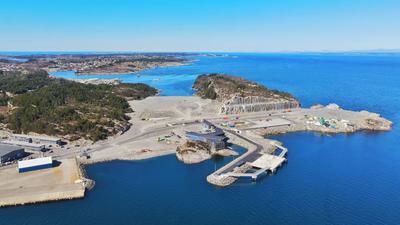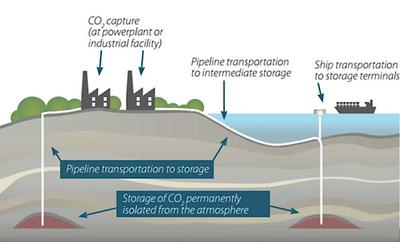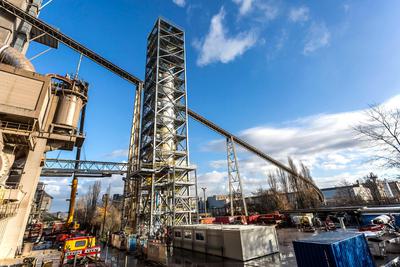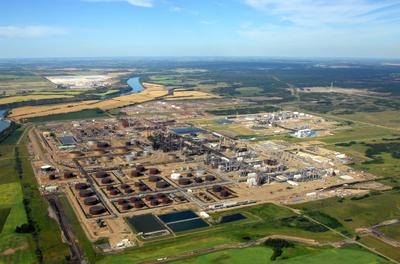CCS advocates see it as the only viable way to get to net zero quickly and of particular use in the cement and steel industries.
While the most recent report by the Intergovernmental Panel on Climate Change (IPCC) projects it’s possible to stay below 2 degrees C of warming without carbon capture, the majority of that report’s future scenarios involve a lot of CCS. In the IPCC’s nearly 100 assessed routes to stay under 1.5 degrees C of warming, an average of 665,000 million metric tons of CO2 gets captured and stored by 2100. The International Energy Agency projects that net-zero carbon emission targets will require a stunning 1,150 million metric tons of CO2 locked away per year by 2030, compared to 40 million tons annually today.
This has some analysts applauding trailblazers like Northern Lights. CCS advocates see it as the only viable way to get to net zero quickly and are encouraged by the new interest in locking away emissions from notoriously dirty industries such as cement and steel manufacture. “It’s integral to the most affordable transitions,” says Niall Mac Dowell, an energy systems engineer at Imperial College London. “There are so many carbon capture initiatives — every country on the planet so far as I can tell seems to be doing something now. It’s good news.”
But others are watching the trend with anxiety, noting that the vast majority of CCS projects thus far have given oil companies incentive to pump out more oil, leading to an increase in net emissions. The Centre for International Environmental Law put out a damning report last July condemning the technology for delaying decarbonization, along with other environmental sins. This January, hundreds of Canadian academics signed a protest letter asking their government not to pass a CCS tax credit for fear of simply subsidizing the fossil fuel industry. “[CCS] has been used since its inception precisely in this way, to delay action to shift away from fossil fuels,” says Matthew Paterson, a climate change politics researcher at Manchester University and a signatory of that Canadian protest letter. “I see no shift in that.”
The idea of CCS is simple: capture CO2 as it’s emitted from some industrial process, concentrate it, compress it, and pump it down to a natural hole in the ground where cap rocks will stop it from leaking back out. Somewhat ironically, some waste needs to be cleaned so that the CO2 is pure enough for disposal; too much nitrogen in the emissions can make it too dilute to compress and lock away.
All this costs money, and until recently there hasn’t been much incentive to do it. “None of these companies are charities,” says Mac Dowell. The reason Equinor got started decades ago was because Norway was one of the first countries in the world to institute a carbon tax, making it cheaper to bury the CO2 than to vent it. The vast majority of CCS projects have so far been in the U.S. for enhanced oil recovery: Companies pump the CO2 down to force out more fossil fuel, providing a cash incentive (and, controversially, creating more emissions from yet more oil).
A new U.S. tax break and a rise in the price of carbon on the European Trading Scheme are giving new incentives for CCS projects.
Now other incentives are coming online. The U.S. has a new tax break for CCS, under the Section 45Q tax credit, of up to $50 per ton. Canada has a federal carbon price now standing at around $40 per ton. And, in Europe, the price of carbon on the European Trading Scheme has ramped up since 2017 to highs near $100 per ton. Those numbers hover around the same price as CCS, which can cost as little as a few tens of dollars to more than $100 per ton, depending on factors like how much the CO2 needs to be cleaned and how far it needs to be transported. That means CCS is looking more viable for other industries.
Take cement, for example. The vast amounts of concrete needed for roads and buildings makes it the second most-consumed product on Earth after clean water. The industry is single-handedly responsible for 6.5 percent of global emissions. Some of that is due to the fossil fuels burned to power the process, and that can be clawed back by using alternative energy sources — primarily burning municipal waste. But the majority of cement’s CO2 emissions comes from the breakdown of the limestone used to make it, and that’s much, much harder to avoid, notes Paul Fennell, a chemical engineer at Imperial College London.
While there are some new alternative cements that use totally different ingredients, they don’t behave the same as ordinary cement, and making that shift would require wholesale rewrites of building codes. So, Fennell says, carbon capture is the best way to make cement a zero-emission industry over the next few decades. The IPCC agrees, calling CCS a “critical mitigation option” for both cement and chemical production.
The Low Emissions Intensity Lime And Cement project's kiln designed for carbon capture in Lixhe, Belgium. LEILAC
Work on CCS for cement is underway. The European Union’s Low Emissions Intensity Lime And Cement (LEILAC) project is now trialling a slightly different kiln design. This simple tweak separates the emissions from the fuel from the purer CO2 emissions from the limestone, so the limestone emissions can be sent off for burial. One of Northern Lights’ first customers is Norcem, which is now working to install carbon capture at its cement plant in Brevik, Norway for 2024.
Steel production is another dirty industry ripe as a client for CCS. It’s responsible for 7 percent of global emissions, largely thanks to the use of coal to break down the iron ores. Fennel says that there are promising new technologies that can whittle that down a lot, particularly by replacing the coal with hydrogen. But carbon capture, he says, provides a way to mop up the remainder of emissions. One steel plant in Saudi Arabia, he notes, has been successfully using CCS since 2016.
Another candidate for CCS is the energy-intensive production of future fuels like hydrogen and ammonia. These are projected to have a huge role to play in the energy sector, particularly for parts of the transport sector including shipping. Both hydrogen and ammonia can be made without carbon, by zapping water with renewable electricity sourced from wind or solar to get “green” products. That’s getting ever-more economically viable. But in the meantime, plenty of analysts foresee a good quantity of so-called “blue” products in the mix: hydrogen or ammonia made from fossil fuels but using CCS to store away the CO2 emissions. Plenty of these projects are under construction, including a massive blue ammonia plant in Abu Dhabi, and another in Louisiana.
“There should be a hard ‘no’ on using CCS to prop up the fossil fuel industries,” says a Canadian scientist.
Fennell thinks the future will hold clusters of new, efficient industrial plants built side-by-side so their emissions can be piped off together. Britain announced a few such clusters in 2021. The Netherlands is aiming to collect industrial emissions and bury them in the North Sea, through its Porthos CCS project. And Northern Lights hopes to achieve the same effect by boat. Its plan is to pick up liquified CO2 by ship from customers as disperse as the north coast of Germany and France, Iceland, Ireland, and Finland, bringing it all to their home port in Norway and then piping it offshore to a single reservoir.
For the first phase of Northern Lights’ operation, 80 percent of their funding comes from the Norwegian government, making it free for companies to have CO2 garbage pickup and disposal. That government boost has “broken the chicken-and-egg situation we have been in for many years,” says Northern Lights communications director Kim Bye Bruun. “Emitters have had nowhere to take their CO2, and the storage facilities had no reason to build pipelines,” he says. That’s changing now, though it isn’t all smooth sailing. “There are challenges — everything we do is new. The contracts are new. It’s a new market,” says Bruun. “That takes a lot of work.”
CCS comes with its own environmental issues, from the water needed to scrub clean dilute streams of CO2, to the damage that can be wreaked by building pipelines through sensitive land, to the possibility of leaks.
Shell's Scotford petrochemical complex near Edmonton, Canada includes a carbon capture project. All Canada Photos / Alamy Stock Photo
A recent special issue of the International Journal of Greenhouse Gas Control concluded that geological leaks are unlikely and can be spotted in time to seal them. This makes long-term storage underground more secure than, say, long-term storage in trees that might be ravaged by forest fires, says Mac Dowell. But even small leaks can cause local health problems, since CO2 is a heavier-than-air gas that can suffocate people and make them feel confused: in February 2020, a leak from a CO2 pipeline in Mississippi sent 49 people to the hospital.
But the main issue is more philosophical. For many, the ideal vision of net zero involves deep and rapid decarbonization, getting humanity off its fossil fuel addiction. With the plummeting price of wind and solar, it seems a backward step to incentivize a waste-disposal technology that prolongs the use of oil or coal. Even for hard-to-decarbonize industries, “CCS is not the answer” writes the Center for International Environmental Law, particularly since capturing emissions from these industries can involve expensive retrofits that make it untenable. Whenever greener options are available, critics argue — like green hydrogen (produced using renewable energy) as opposed to blue — those should be the first or only priority. “There should be a hard ‘no’ on using CCS to prop up the fossil fuel industries, including for blue hydrogen,” says Emily Eaton who studies just fuel transitions at the University of Regina, Saskatchewan and was another signatory on the Canadian protest letter. “All the science tells us we need to start phasing out fossil fuel production, not just lowering its emissions, now.”
“Regardless of your take on the CCS debate, carbon capture and storage should at the very least be part of the discussion,” says an advocacy group.
For others, including Mac Dowell, there’s no moral problem with CCS even when it’s used for fossil fuels: the emissions aren’t going into the air, and it reduces the financial pain of some hard energy transitions. And it’s important to remember, says Mac Dowell, that renewables like wind and solar come with their own issues, from child and forced labor to environmental pollution from mineral mining. “What I would have thought we want are thoughtful, reliable supplies of energy while not messing up the environment,” he says. For him, that doesn’t mean decarbonizing takes priority.
The climate advocacy group Extinction Rebellion, for one, recognizes both viewpoints as reasonable: “Regardless of your take on the CCS debate, carbon capture and storage should at the very least be part of the discussion,” it concludes.
As the Northern Lights project shows, a lot of policy tools are needed to get these projects going, from grants to tax breaks to carbon pricing; whether there are enough of those to ramp up CCS to the scale in many IPCC projections is unclear. Mac Dowell, for one, hopes so. “Okay now we’ve got these net-zero targets, what do we need to do?” he says. “And the answer is everything as fast as humanly possible. We need everything, yesterday.”






